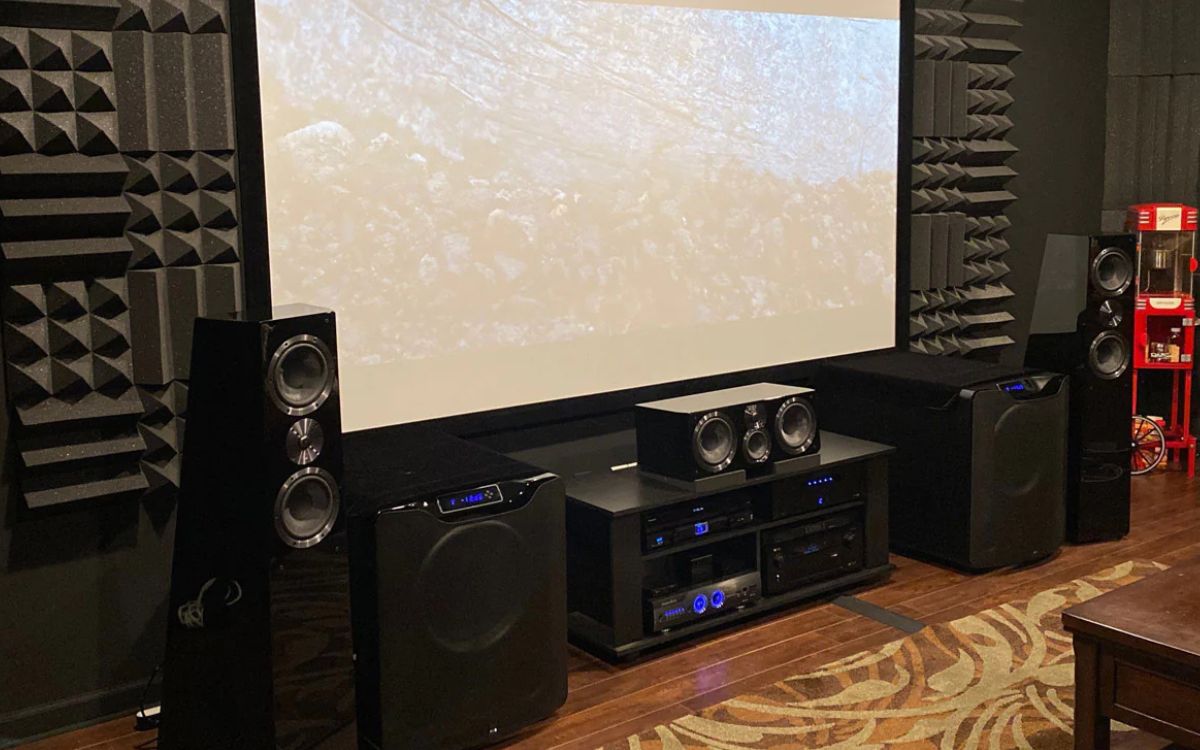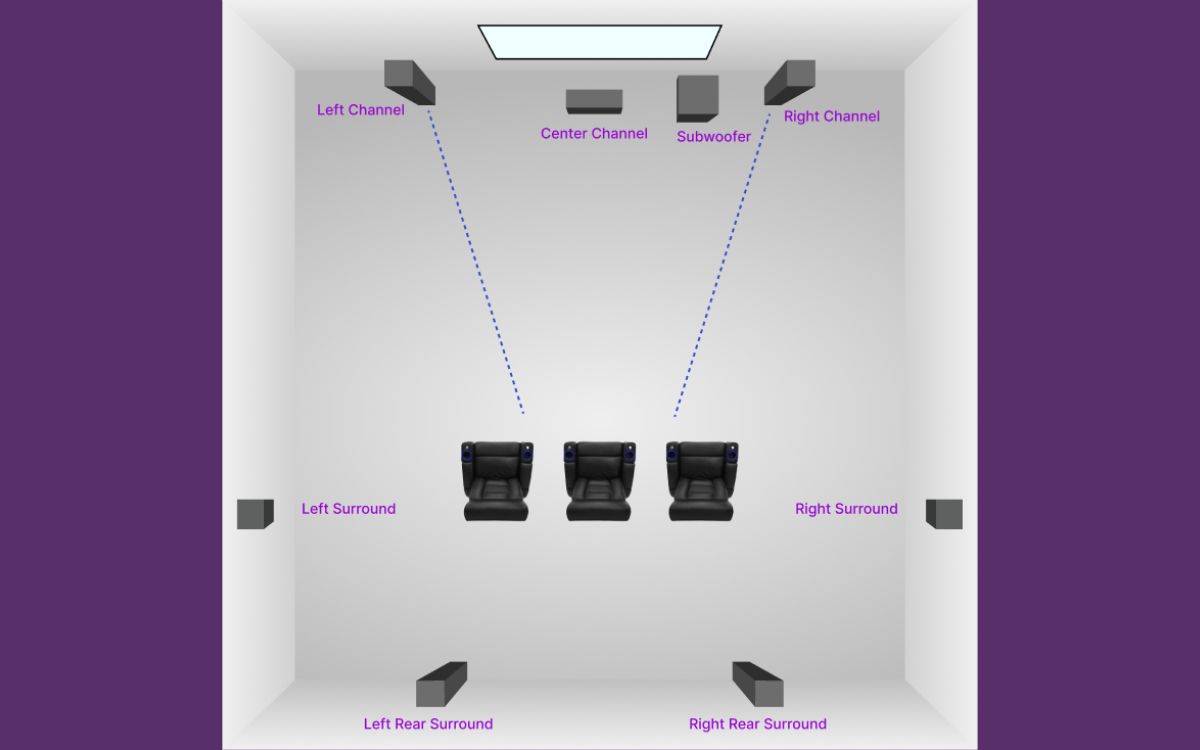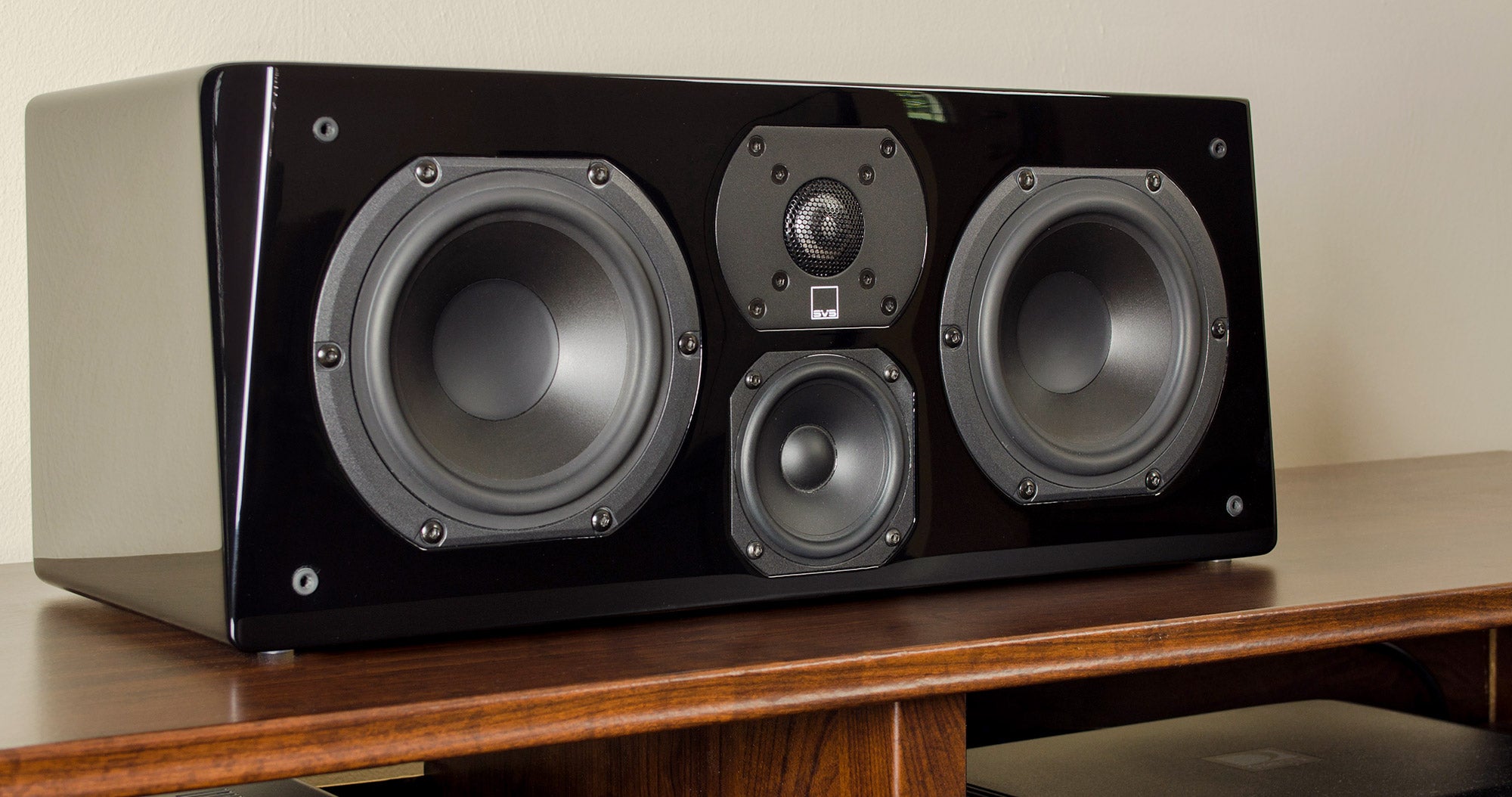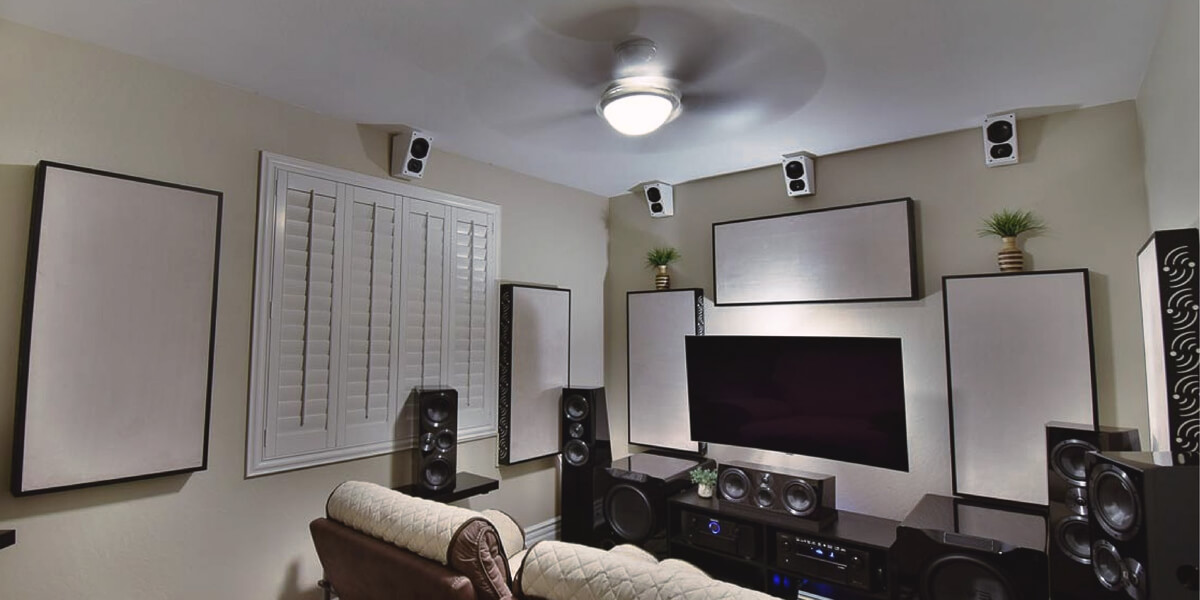Home>Production & Technology>Surround Sound>What Does Center Channel Speaker Do In Surround Sound


Surround Sound
What Does Center Channel Speaker Do In Surround Sound
Modified: January 22, 2024
Learn how a center channel speaker enhances your surround sound experience and delivers clear dialogue for an immersive audio setup. Explore the benefits of incorporating a center channel in your surround sound system today!
(Many of the links in this article redirect to a specific reviewed product. Your purchase of these products through affiliate links helps to generate commission for AudioLover.com, at no extra cost. Learn more)
Table of Contents
Introduction
Welcome to the world of surround sound systems, where the immersive audio experience brings movies, music, and games to life like never before. Whether you’re a cinephile, an audiophile, or a gaming enthusiast, surround sound adds a layer of depth and realism to your favorite media. At the heart of every surround sound setup is the center channel speaker, a crucial component responsible for delivering clear dialogues and anchoring the audio in the center of the soundstage.
In this article, we will delve into the role of the center channel speaker in a surround sound system, exploring its function, importance, and how it contributes to an immersive audio experience. By understanding the significance of the center channel speaker, you’ll be able to make informed decisions when setting up and optimizing your surround sound system.
So, let’s dive in and discover what the center channel speaker does in a surround sound system and why it is an essential component for an exceptional audio experience.
Understanding Surround Sound Systems
Before we delve into the role of the center channel speaker, let’s have a brief overview of how surround sound systems work. Surround sound is a technology that creates a multidimensional audio environment to enhance the overall listening experience. It involves multiple speakers strategically placed around the listener to create an immersive soundstage.
A standard surround sound system typically consists of a combination of front, center, and rear speakers, along with a subwoofer for added bass. The front speakers, including the left and right speakers, handle most of the audio, while the center channel speaker focuses on dialogue and vocal reproduction. The rear speakers provide ambient sounds and additional depth to the surround sound effect.
Surround sound systems are commonly denoted by numbers, such as 2.1, 5.1, 7.1, or 9.1. The first number represents the number of main speakers (including the center channel), and the second number indicates the number of subwoofers in the system. For example, a 5.1 surround sound system consists of five main speakers (front left, front right, center, rear left, and rear right) and one subwoofer.
Now that we have a basic understanding of surround sound systems, let’s explore the role of the center channel speaker in more detail.
The Role of Center Channel Speaker in Surround Sound
The center channel speaker plays a vital role in a surround sound system by conveying clear and focused dialogues, anchoring the audio to the center of the soundstage. It serves as the primary source for vocals and speech, ensuring that every word is intelligible and well-defined.
When watching movies or TV shows, dialogues are essential for understanding the plot and character interactions. Without a dedicated center channel speaker, dialogues may get muffled or overshadowed by other sounds, such as background music or sound effects. The center channel speaker’s specialized design and positioning ensure that dialogues are accurately reproduced and stand out prominently, leading to a more immersive viewing experience.
In addition to dialogues, the center channel speaker also helps in creating a seamless and cohesive soundstage. By focusing on vocal reproduction, it balances the audio between the left and right speakers, ensuring that sounds move smoothly across the front of the room. This creates a realistic and immersive experience where sounds appear to originate from their correct positions on the screen.
The center channel speaker also aids in sound localization, allowing the listener to accurately identify the source of a sound. By keeping dialogues and other center-focused sounds in one dedicated speaker, the surround sound system achieves better sound imaging, making it easier to locate where the sound is coming from.
Furthermore, the center channel speaker helps balance the audio frequencies in a surround sound system. It is specially designed to handle the mid-range frequencies, which are crucial for vocal reproduction. By having a separate speaker dedicated to these frequencies, the system can distribute the workload effectively, resulting in clearer and more accurate sound reproduction.
Overall, the center channel speaker plays a critical role in delivering a rich and immersive surround sound experience by ensuring clear dialogues, enhanced sound localization, balanced audio frequencies, and a seamless soundstage.
Importance of Dialogues and Vocal Clarity
Dialogues form the backbone of any movie or TV show, conveying the story, character development, and emotional nuances. Therefore, it is crucial to have a center channel speaker in a surround sound system to ensure the clear reproduction of dialogues and vocal clarity.
Without a dedicated center channel speaker, dialogues can often get lost or muffled in the mix. This can lead to frustration and difficulty in understanding the plot or following the conversations on screen. The center channel speaker focuses on reproducing dialogues, ensuring that each word is articulate and easily discernible. It acts as a dedicated voice for the characters, bringing them to life with clarity and realism.
Moreover, the center channel speaker helps to overcome any challenges posed by room acoustics or background noises. It functions as a directional speaker, projecting sound directly towards the listener. This allows for better control of audio dispersion and minimizes the impact of reflections or sound bouncing off walls, resulting in improved vocal intelligibility.
Vocal clarity is of utmost importance when it comes to enjoying movies, TV shows, or even video games. Without clear and intelligible vocals, the emotional impact of a performance is lost, and the viewer’s engagement with the content is significantly diminished. The center channel speaker ensures that every whisper, every line of dialogue, and every vocal nuance is faithfully reproduced, creating a powerful connection between the viewer and the on-screen characters.
Furthermore, dialogues often carry critical information or plot developments. Be it a suspenseful conversation, a crucial revelation, or a memorable one-liner, dialogues contribute significantly to the overall storytelling experience. The center channel speaker ensures that these moments are delivered with the utmost clarity and impact, maximizing the viewer’s understanding and emotional involvement.
In summary, the center channel speaker’s role in delivering clear dialogues and vocal clarity cannot be overstated. It allows for a more immersive and rewarding audio experience, where every dialogue is easily understood, character voices come to life, and the intricacies of performances are fully appreciated.
Enhanced Sound Localization and Imaging
One of the distinct advantages of a surround sound system with a center channel speaker is the enhanced sound localization and imaging it provides. Sound localization refers to the ability to pinpoint the location from which a sound originates, while sound imaging refers to the perception of the sound’s position in relation to the visual elements on the screen.
The center channel speaker plays a vital role in sound localization by anchoring the dialogues and center-focused sounds to the center of the soundstage. This ensures that the sound appears to come from the direction of the on-screen actors or objects. When a character speaks or an event occurs in the center of the screen, the center channel speaker accurately reproduces the sound, creating a more realistic and immersive experience.
Furthermore, sound imaging is greatly improved with a well-placed center channel speaker. By centering the dialogues and vocals, the system can create a seamless audio-visual experience. This means that when a character moves from the left side of the screen to the right, their voice will maintain a consistent position in the soundstage, enhancing the believability of the scene.
Without a dedicated center channel speaker, dialogues and vocals would be spread across the front left and right speakers. This can lead to difficulties in localizing sound accurately, as the audio may seem to come from a different direction than the visual source. The center channel speaker helps to align the audio and visual elements, ensuring a cohesive and realistic audio experience.
Moreover, the enhanced sound localization and imaging provided by the center channel speaker contribute to a more immersive gaming experience. In video games, being able to accurately locate the source of sounds such as footsteps, gunfire, or approaching enemies is crucial for gameplay. The center channel speaker helps in precisely positioning these audio cues, allowing gamers to react quickly and strategically.
Overall, the center channel speaker’s role in enhancing sound localization and imaging cannot be underestimated. By anchoring dialogues and center-focused sounds to the center of the soundstage, it creates a more realistic and immersive audio experience, aligning the audio with the on-screen visuals and enhancing the overall enjoyment of movies, TV shows, and games.
Balancing Audio Frequencies
Another crucial role of the center channel speaker in a surround sound system is to balance the audio frequencies. Each speaker in a surround sound setup is designed to handle specific frequency ranges, and the center channel speaker excels at reproducing mid-range frequencies.
Mid-range frequencies, ranging from approximately 200 Hz to 2,000 Hz, are important for vocal reproduction. They encompass the frequencies at which most human voices lie, making them essential for clear and intelligible dialogues. By having a separate center channel speaker dedicated to these frequencies, the system can distribute the workload effectively, ensuring that the vocals are reproduced accurately and with ample clarity.
Without a dedicated center channel speaker, the burden of reproducing mid-range frequencies would fall on the front left and right speakers. This can cause a mismatch in audio frequencies across the front soundstage and result in muddled dialogues. By offloading the mid-range frequencies to the center channel speaker, it allows the front speakers to focus on their respective frequency ranges, creating a more balanced and cohesive audio experience.
In addition to balancing audio frequencies, the center channel speaker also helps in blending the audio seamlessly across the soundstage. As the center channel speaker is placed directly above or below the display, it ensures that the sound appears to be coming from the screen itself, aligning the audio with the visual elements. This creates a more immersive experience, where the dialogues and vocals are precisely localized in relation to the on-screen action.
Furthermore, by having a separate speaker dedicated to mid-range frequencies, the center channel speaker can be optimized and fine-tuned for vocal reproduction. This means that it can be designed with specific driver configurations, enclosure designs, and equalization settings to ensure optimal clarity and presence of dialogues. The result is a more refined and accurate portrayal of the human voice, enhancing the overall audio experience.
In summary, the center channel speaker’s role in balancing audio frequencies is instrumental in ensuring clear and intelligible dialogues. By handling the mid-range frequencies, it allows for a more balanced distribution of audio workload and ensures that vocals are reproduced accurately. Additionally, the center channel speaker aids in seamlessly blending the audio with the visual elements, creating a cohesive and immersive experience for the listeners.
Achieving a Seamless Soundstage
A vital aspect of a surround sound system is creating a seamless soundstage, where sounds move fluidly across the room and appear to originate from their correct positions. The center channel speaker plays a significant role in achieving this cohesive and immersive audio experience.
The center channel speaker acts as the anchor for the soundstage, providing a stable and centered point of reference for audio elements, such as dialogues and vocals. By having a dedicated speaker for these center-focused sounds, the system can ensure that they are precisely localized and emanate from the center of the room.
When watching movies or TV shows, sounds often pan from one side of the screen to the other as the action unfolds. The center channel speaker, along with the left and right speakers, works harmoniously to create a smooth transition as sounds move across the front soundstage. This enhances the realism of the audio by accurately matching the location of sounds with the visuals on the screen.
Without a center channel speaker, dialogues and vocals would be spread across the left and right speakers, leading to an unrealistic audio experience. Sounds might appear to jump abruptly from one side to the other as they move across the scene, disrupting the cohesiveness and immersion of the listener.
In addition, the center channel speaker helps in creating a balanced audio image. With a dedicated center speaker, the audio landscape is more evenly distributed, ensuring that no particular speaker dominates the soundstage. This contributes to a well-rounded and natural audio experience where all elements are seamlessly integrated.
Furthermore, the center channel speaker aids in maintaining a consistent and coherent soundstage, regardless of the listener’s position within the room. Since the center channel speaker takes on the responsibility of dialogues and center-focused sounds, it ensures that these audio elements are equally audible and balanced, allowing everyone in the room to enjoy a consistent listening experience.
Overall, the center channel speaker is essential for achieving a seamless soundstage in a surround sound system. By providing a stable and centered reference point, it allows for a smooth transition as sounds move across the front soundstage, creates a balanced audio image, and ensures a consistent listening experience for all viewers.
Conclusion
The center channel speaker plays a crucial role in a surround sound system, delivering clear dialogues, enhancing sound localization, balancing audio frequencies, and achieving a seamless soundstage. By focusing on vocal reproduction, the center channel speaker ensures that dialogues and vocals are intelligible and well-defined, adding depth and realism to movies, TV shows, and games.
Through its dedicated placement and specialized design, the center channel speaker anchors the audio in the center of the soundstage, creating a cohesive and immersive listening experience. It allows for enhanced sound localization and imaging, making it easier to identify the source of a sound and accurately position it in relation to the on-screen visuals.
In addition, the center channel speaker is responsible for balancing audio frequencies, particularly in the mid-range. By offloading the mid-range frequencies to a separate speaker, it ensures that dialogues are clear and intelligible, while also allowing other speakers to focus on their respective frequency ranges.
Moreover, the center channel speaker contributes to achieving a seamless soundstage, ensuring that sounds move smoothly across the room and appear to originate from their correct positions. This enhances the realism of the audio and creates a more immersive listening experience for the viewers.
In conclusion, the center channel speaker is an essential component of a surround sound system. Its role in delivering clear dialogues, enhancing sound localization, balancing audio frequencies, and achieving a seamless soundstage cannot be overstated. By understanding the importance of the center channel speaker, you can optimize your surround sound system and elevate your audio experience to new heights.











